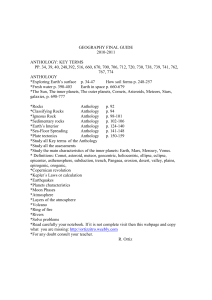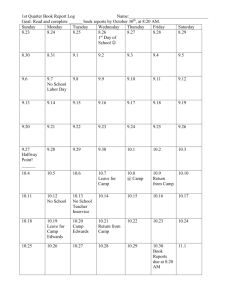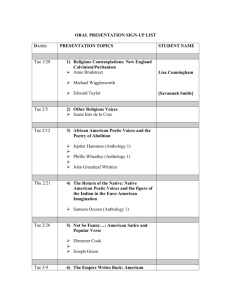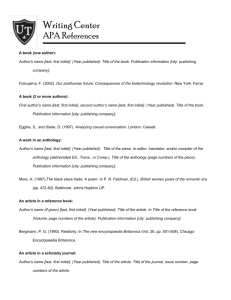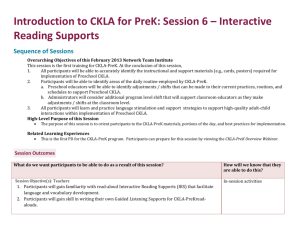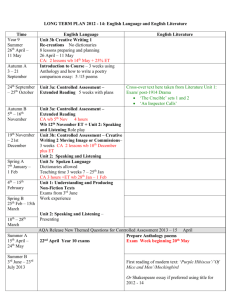Domain Planning Template
advertisement
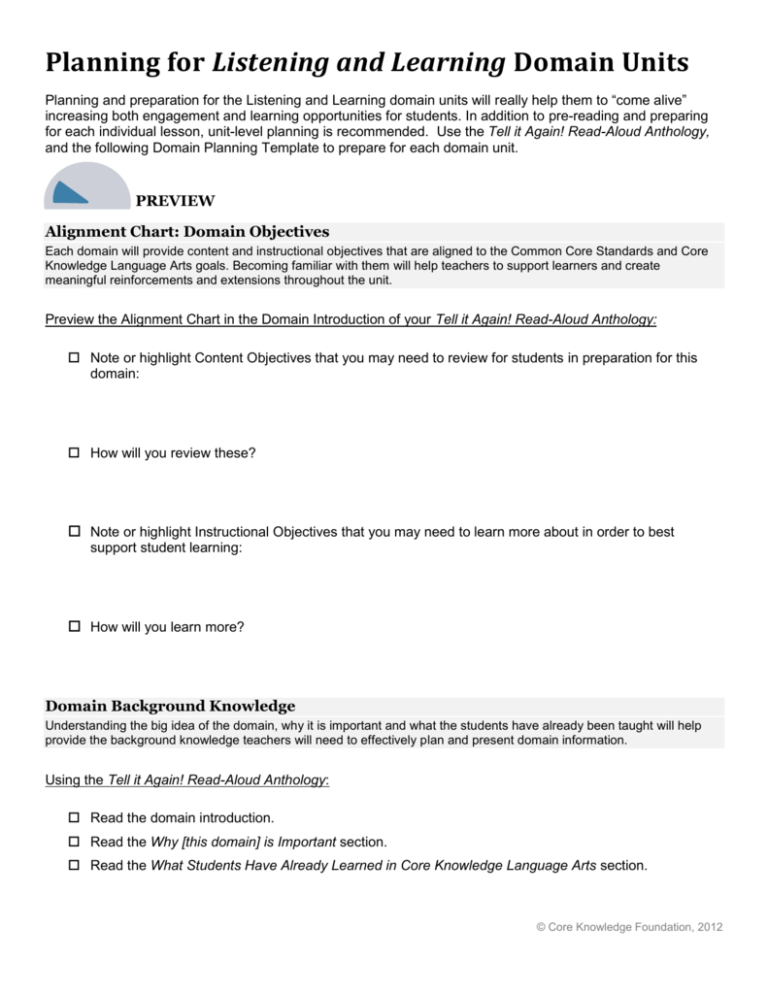
Planning for Listening and Learning Domain Units Planning and preparation for the Listening and Learning domain units will really help them to “come alive” increasing both engagement and learning opportunities for students. In addition to pre-reading and preparing for each individual lesson, unit-level planning is recommended. Use the Tell it Again! Read-Aloud Anthology, and the following Domain Planning Template to prepare for each domain unit. PREVIEW Alignment Chart: Domain Objectives Each domain will provide content and instructional objectives that are aligned to the Common Core Standards and Core Knowledge Language Arts goals. Becoming familiar with them will help teachers to support learners and create meaningful reinforcements and extensions throughout the unit. Preview the Alignment Chart in the Domain Introduction of your Tell it Again! Read-Aloud Anthology: Note or highlight Content Objectives that you may need to review for students in preparation for this domain: How will you review these? Note or highlight Instructional Objectives that you may need to learn more about in order to best support student learning: How will you learn more? Domain Background Knowledge Understanding the big idea of the domain, why it is important and what the students have already been taught will help provide the background knowledge teachers will need to effectively plan and present domain information. Using the Tell it Again! Read-Aloud Anthology: Read the domain introduction. Read the Why [this domain] is Important section. Read the What Students Have Already Learned in Core Knowledge Language Arts section. © Core Knowledge Foundation, 2012 PACE Pacing Calendar Planning for the domain with pacing in mind will allow teachers to present the domain smoothly and ensure that an appropriate amount of time is allocated to the domain. Review the pacing calendar provided in the domain introduction. It may be helpful to document this information in calendar format, adjusting for weekends, holidays, and aligning the domain pacing calendar with the school calendar for days when instruction is not scheduled. Pacing allows you to consider your students needs and interests in a proactive way. Pacing ensures that you will have the time you need as you move through each topic within a domain, to provide support based on the specific needs of your classroom. Using the PACING CALENDAR IN THE DOMAIN INTRODUCTION: Identify the number of lessons in this domain:________________________________________ What is the maximum number of days for this domain?: ________________________________ (1 day for each lesson + 1 day for each: Pausing Point, Domain Review, Domain Assessment, Culminating Activity) Note the lessons that include Student Performance Task Assessments:__________________ Note which lessons are followed by a Pausing Point: __________________________________ Note the lessons requiring advance preparation and/or additional materials:_________________ PULL IT TOGETHER Materials, Recommended Resources The Listening and Learning strand provides you all the materials required to implement the program. However, becoming familiar with these materials, organizing them and preparing them for use during the read aloud, and extending the required materials with additional resources are critical steps in ‘making the lessons’ your own. To support you, required materials are listed in the Domain Components section of the Introduction, additional materials suggested will be listed in the Introduction and under the materials column in the “At A Glance” box for each lesson. Further materials you may consider for extension and reinforcement are listed in the Domain Introduction, under the section Recommended Resources. Here you will see tradebook lists, website lists, and other resources that you may want to consider and which are aligned with the domain content. Using THE DOMAIN INTRODUCTION: Note the Domain Components you will need to teach this Domain: Additional Materials: (specific materials needed in the “At A Glance Box” for each individual lesson) © Core Knowledge Foundation, 2012 Using the RECOMMENDED RESOURCES SECTION IN THE DOMAIN INTRODUCTION: Preview the Trade Book List. Identify the trade books available (in the classroom or from the library) Note any additional images, props, materials or resources related to the domain that you may have available: Using the Websites and Other Resources section in the Domain Introduction: Identify Internet, multimedia, and/or local resources specific to this domain: Document any extension opportunities based on current events, your students and their local community, local events and resources, etc.: Document ideas for cross-curricular connections: The Supplemental Guide The Supplemental Guide is a separate publication available to assist with the instruction of English Language Learners and students with Special Needs. It also serves as a reference to you, as it includes varied/additional vocabulary activities, syntax activities, and approaches to comprehension and discussion. It can be used instead of the Anthology in some cases, or as a guide for center activities to supplement lessons. It can also be used by specialists in small groups to support the classroom’s learning. Examining the Supplemental Guide during planning allows the teacher to consider the materials already available to support diverse learners in the classroom. Preview the Supplemental Guide Decide if you will use the Supplemental Guide as… Your primary guide for the domain © Core Knowledge Foundation, 2012 Supplement some of the lessons, and then transition to the Anthology Choose individual activities to augment the content of the Anthology Parent Take-Home Letters Each domain includes Parent Take Home Letters located in the Teacher Reference section in the back of the Tell It Again! Read Aloud Anthology. These take home letters will help to introduce the family to the domain content and vocabulary and will provide ideas on how to support learning at home. Resource lists, including trade books and other multimedia are provided. Reviewing these in planning helps you prepare for ways to support family involvement and adjust or add to the standard letters as needed for your classroom. Using the Teacher Reference section of the Anthology: Preview the Take Home Letters. Note which lessons the Take Home letters will be sent out (lesson numbers in upper-left hand corner: CORE VOCABULARY The Core Vocabulary list in the introduction to each domain contains all of the words that appear boldfaced in the readaloud text. The inclusion of the words on this list does not mean that students are expected to immediately be able to use all of these words on their own. However, through repeated exposure throughout the lessons, extension activities, and related classroom conversation, students should acquire a good understanding of most of these words and begin to use some of them in their own conversation. Teachers’ familiarity with the Core Vocabulary list will allow them to support learning by intentionally modeling the words and encouraging their use when opportunity arises. If a Supplemental Guide is available, consider using the Multiple Meaning Word Activities for each lesson for definitions, syntactic awareness and vocabulary instruction activities. Using the Core Vocabulary Chart in the Domain Introduction: Review core vocabulary for the domain. Definitions appear in the Core Vocabulary section at the beginning of the lesson that contains each word. List props or visuals you may have to support students learning this vocabulary: As you pre-read each read-aloud: Note additional vocabulary for which students may need instruction to fully understand the read-aloud: © Core Knowledge Foundation, 2012 PERFORMANCE Student Performance Task Assessments: Informal and Formal There are numerous opportunities to assess students’ learning. These assessment opportunities range from informal observations, such as Think Pair Share and some Extension activities, to more formal written assessments. The Student Performance Task Assessments (SPTA’s) are identified in the Tell It Again! Read-Aloud Anthology, with a tens icon. There is also an end-of-domain summative assessment. Pausing Point Activities can provide activities to reteach concepts. The Above and Beyond section of each lesson can provide activities for students who are above grade level. Students who are English Language Learners or who have Special Needs, may benefit from the enhanced oral language practice activities in the Supplemental Guide Using the Teacher Reference section of the Anthology: Locate the Student Instructional Masters and Answer Keys for the Student Performance Task Assessments for the domain. Compare the domain assessments and answer keys to the core content objectives, marking on the assessment answer key which lessons address the assessment items. Consider and mark which items might guide creation of your own mid-unit assessment. Using the PAUSING POINT ACTIVITIES throughout the Tell it Again! Read-Aloud Anthology: Review the pausing point activities, noting on the assessment key, which activities might offer appropriate support for the assessment item (for remediation purposes). Mark an “L” next to those that you might want to include as part of— or an extension to—a particular domain lesson. Mark a “PP” next to those that you might want to use during the domain pausing points. Using the Extensions throughout the Tell it Again! Read-Aloud Anthology: Preview the Above and Beyond activities: Mark which activities you may want to use: Using the Domain Review and the Culminating Activities sections: Preview the Domain Review and Culminating Activities. Mark which activities you may want to use: PRESENTATION © Core Knowledge Foundation, 2012
